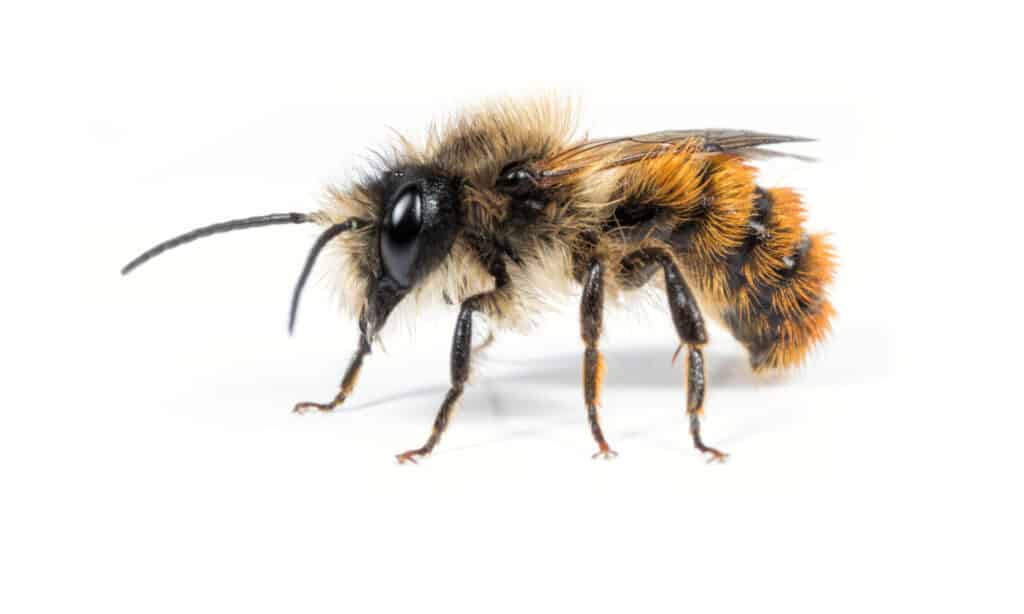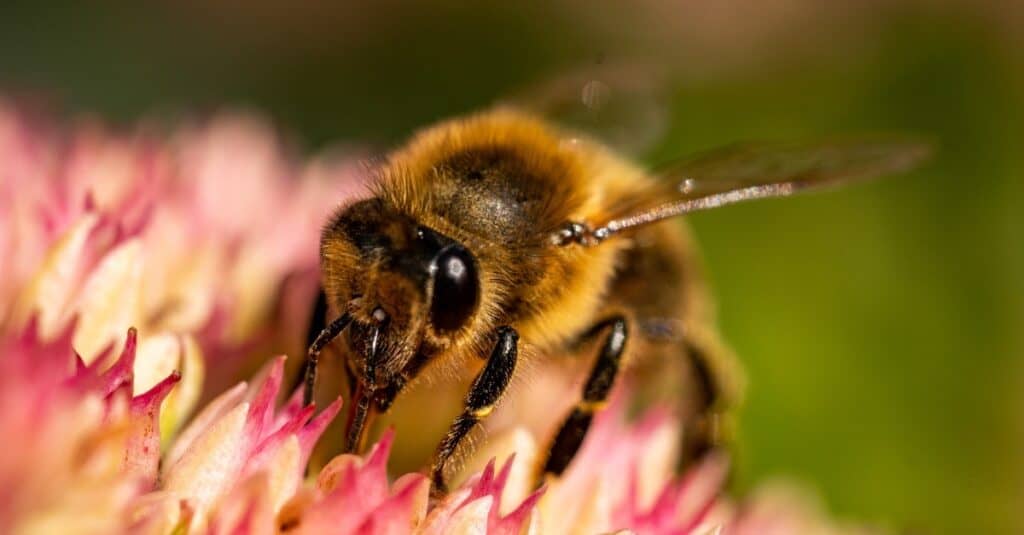The most widely used insects on the planet are honey bees. These yellow-striped creatures are essential because they pollinate food crops. Pollination is when insects move pollen from one plant to another, fertilizing the plants to produce fruit, vegetables, seeds, and so on. European honey bees are excellent pollinators, and their hives produce wax, honey, and propolis. Mason bees are becoming more popular in backyards and orchards as they are also good at pollinating, maybe even better than honey bees. Yet, these two sorts of bees are almost opposite in every manner. So, what are the differences between Mason bees vs honey bees? Why would someone prefer one variety of bees over another? Below, we will explore the key features that set the two species apart.
Comparing a Mason Bee and a Honey Bee

| Mason Bee | Honey Bee | |
|---|---|---|
| Appearance | – smaller than honey bees, ranges from 1/4 to 3/4 of an inch in length – dark blue, but they appear almost black | – larger than Mason bees, grows to 3/4 of an inch long – golden-yellow colors and brown bands |
| Habitat | – solitary insects; live in small spaces using mud or other “masonry” products while constructing their nest | – live together as a colony in a hive |
| Pollination | – Scopa hairs are their special feature. These scopa suck up pollen extremely well and coat the bee in a thick powder of pollen grains. | – Have “pollen baskets” on their hind legs, and they will push pollen grains to this basket and use saliva to stick them together. |
| Sting | – sting is comparable to a mosquito bite, but not fatal. | – sting can be excruciatingly unpleasant and even life-threatening |
| Lifecycle | – Both males and females die shortly after mating. | – Queen lives 3-4 years, while Drones usually die after mating |
The 5 Key Differences Between a Mason Bee and a Honey Bee
The main differences between a Mason bee and a honey bee include their appearance, habitat, pollination, sting, and lifecycle. When it comes to beneficial insects that help pollinate our world, honey bees seem to get all of the attention. The sweet honey that they produce goes a long way towards allowing them to climb the popularity ladder. However, the Mason bee family had over 150 species responsible for pollination long before European honey bees arrived. And they can pollinate up to 2,000 flowers every day, with each one capable of performing the task of 100 honey bees. These two creatures couldn’t be more different, and we’ll go through each of their differences in detail.
Mason Bee vs Honey Bee: Appearance

Honey bees are more easily recognized than Mason bees.
©Ed Phillips/Shutterstock.com
Imagine a honey bee with your eyes closed. Easy, right? The honey bee is an exceedingly popular symbol, with four tiny wings, a sharp stinger, hairy bodies, and alternating stripes. Mason bee imagery is not nearly as prominent. They are approximately half an inch smaller than typical honey bees and are dark blue or almost black. Mason bees also have metallic abdomens and resemble fuzzy black flies.
Honey bees are one of the most easily recognized insects and the world’s most widely domesticated bee species. They are about 3/4 inch long and come in many colors, but most are brown with a band of golden-yellow and a brown abdomen.
Mason Bee vs Honey Bee: Habitat

While Mason bees are solitary, honey bees live together as a colony in a hive.
©iStock.com/Niklas Toelle
Mason bees are solitary. Each female is a queen and a worker in her own right. While constructing their nest, they lay eggs in small places using mud or other “masonry” products. They place larvae in these structures, with pollen walls as a food supply for the larvae and mud walls to separate them.
Honey bees live together as a colony in a hive. A honey bee hive can have tens of thousands of bees inside, including a queen, drones, and workers. The workers are all female, but the queen’s pheromone limits all of the workers’ reproductive ability, making her the solitary egg-layer. She’s also the only bee capable of mating with drones. Without her pheromones, the workers can’t pair and deposit female eggs.
Mason Bee vs Honey Bee: Pollination

Mason bees have scopa hairs, which honey bees lack.
©Jaco Visser/Shutterstock.com
Scopa hairs are a feature of Mason bees that honey bees lack. This scopa is microscopically branched hairs that suck up pollen extremely well and coat the bee in a dense powder. Mason bees collect pollen all over their bodies when their bellies flop onto flowers. They pollinate 95% of the flowers they visit.
Honey bees have roughly 3 million strands of hair on their bodies but do not have the scopa found in Mason bees. They have “pollen baskets” on their hind legs, which they utilize to push pollen grains into and bind them with saliva. Honey bees will travel considerable distances, making this an efficient method of carrying food back to the hive. Because they primarily focus on nectar, they only pollinate roughly 5% of the flowers they land on.
Mason Bee vs Honey Bee: Sting
Mason bees are known for their gentleness and almost complete lack of stinging ability. In terms of pain, its sting is comparable to that of a mosquito bite. Because the Mason bee lacks a barbed stinger, she can sting multiple times, but the stingers are tiny and carry little venom. They also have a hard time penetrating human skin and are only known to sting when crushed or handled aggressively.
A honey bee jabs a barbed stinger into the skin. The sting venom comprises proteins that cause pain and inflammation around the sting site by affecting skin cells and the immune system. It can cause a more serious immune system reaction in people with allergies to bee stings and even be life-threatening.
Mason Bee vs Honey Bee: Lifecycle
A single female Mason bee can lay 25-30 eggs a day. Both males and females die shortly after mating. The eggs hatch, the larvae eat food supplies, then transform into cocoons. Days later, the larvae fully form into adult bees.
The queen honey bee lives 3-4 years, while drones usually die after mating with the queen.
Thank you for reading! Have some feedback for us? Contact the AZ Animals editorial team.








